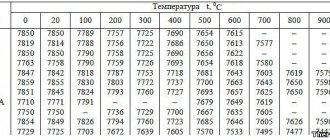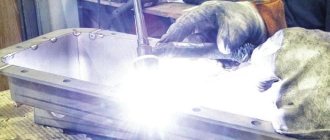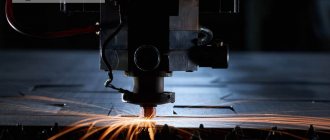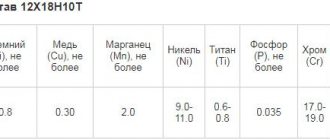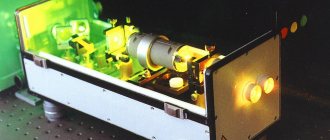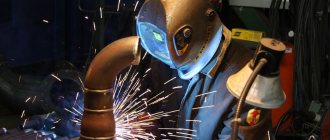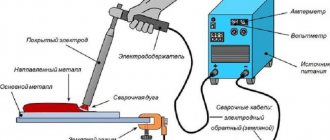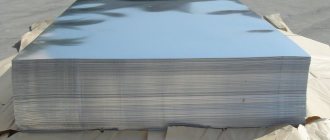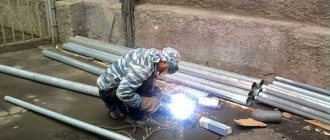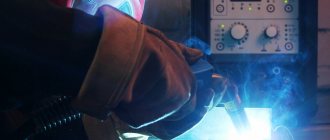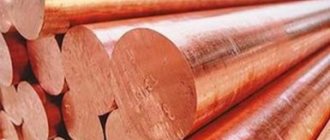04/13/2021 Author: VT-METALL
Issues discussed in the material:
- Principle of laser pipe welding
- Advantages and disadvantages of laser pipe welding
- Operating Parameters of Laser Welding
- Complete set of equipment for laser pipe welding
- Types of laser welding
Laser pipe welding is a technology that appeared relatively recently, but has already become in demand and proven its effectiveness. Unlike conventional methods of joining the edges of parts by melting, it provides greater production speed with a higher quality weld.
Both manual and automated installations with different types of lasers are used. From our material you will learn about the main nuances of using laser pipe welding, the advantages and disadvantages of the technology, and the types of equipment used.
Physical properties of the process
The laser method differs from other methods in its increased energy density at the heating site - 1 MW per cm². This helps to speed up the process of formation of the welded joint and reduce the duration of the thermal effect on the areas adjacent to the seam. When laser welding of metal, deformations, foreign inclusions or cracks rarely occur.
The size of the area of influence of the welding installation lies in the range of 0.2-13 mm. The penetration depth depends on the laser radiation power and the location of the focal plane of the flow. The molten metal moves with the beam, forming a welded joint.
It turns out to be deep and narrow, so it is very different from the seams formed when using other technologies.
How laser welding works
In a laser device, 2 types of components are used to generate radiation: gas and solid-state. The power of the first reaches 25 kW. Their design includes a hollow tube containing a gas mixture. The power of solid-state generators does not exceed 6 kW. They are a ruby or garnet rod reinforced with neodymium.
The principle of operation is to generate a light flux, which enters a system of mirrors through an optical resonator. The energy required to melt the metal is generated when the beam passes through a focusing lens. The operating parameters of the welding installation are set manually or automatically.
When using a machine with CNC (computer numerical control), the direct participation of the master in the process is not required. In manual laser welding, the operator moves the unit head using a remote control.
Complete set of equipment for laser pipe welding
Based on the equipment equipped with automatic devices, laser welding systems are divided into only two types: manual and automatic.
The first type is used mainly in medium or small metalworking enterprises. The term “manual” does not mean that the welding process is performed only with the help of hands. The dimensions of the welding machine are quite impressive. Most models are equipped with wheelsets for moving and installing to another location.
The second option is used exclusively in large industrial production, primarily in the engineering and shipbuilding industries due to the high cost of equipment.
Industrial laser welding systems always have the same equipment, which includes:
- Cooling system.
- Power supply.
- Optical resonator.
- Control system for laser power, focusing and movement.
- A gas supply system that is used to protect the surfaces of the surfaces (or elements) being welded.
- Block for moving the workpiece and beam.
- Focus block.
- Welding head equipped with lens.
- Technological laser (solid-state or gas).
Laser welding machines for pipes and other metal products can be equipped with CCD monitors or microscopes, which make it easier to control work processes associated with repair work (soldering, welding) of very small workpieces.
Welding equipment can be supplied in several configurations. There are also portal or console installations, and there may be robotic manipulators. The equipment can be controlled using automatic machines (equipped with CNC systems) or manually (using a remote control). In the first option, the use of special programs is provided, and in the second, control of movement, speed and work process is assigned to the operator.
Industrial equipment is equipped with one of two types of laser: solid-state or gas, or a mixed version is used.
Classification of welding modes and scope of application
They use 2 modes of forming connections with a laser:
- Point method. In this case, the unit produces pulsed radiation. This welding method is used to join thin metal workpieces.
- Suture technology. Both pulsed and continuous radiation are used. The weld is formed by overlapping areas of spot heating. The operating speed is determined by the pulse frequency. The method is used to obtain deep connections on thick parts.
- Hybrid method. In this case, filler wire is used. The apparatus is equipped with feeding mechanisms. The consumable material is discharged into the weld pool simultaneously with the movement of the unit head. The method is used to form complex metal structures. The thickness of the wire is selected in accordance with the width of the connection.
We recommend reading Features of pulse welding
The main areas of application of laser technology are:
- Electronics and instrumentation. Laser joins parts of different compositions and thicknesses. The method helps to cook components located near chips of microcircuits or other elements sensitive to high temperatures.
- Automotive industry. Laser welding is used to repair bodywork and aluminum parts.
- Military industry, shipbuilding, nuclear energy. Using the technology under consideration, parts made of titanium, a difficult metal to weld, are connected.
The gradual reduction in the cost of laser systems makes it possible to use them on construction sites and even in domestic conditions.
Principle of laser pipe welding
Recently, an increase in the volume of laying and repairing pipelines, as well as increasing requirements for the quality of pipe connections, force us to constantly work on the development of welding technologies and modernization of equipment.
With the advent of high-performance fiber laser systems in industry, the level of development of metal processing technologies has increased significantly. With the use of laser pipe welding, it has become possible to achieve high quality welds thanks to the following technical characteristics:
- the process is carried out in deep (“dagger”) melting mode;
- welding is performed at high speed;
- The heat affected zone (HAZ) and the volume of molten metal are insignificant.
In addition, fiber laser systems transmit radiation over a long distance from the source, and the beam can move along almost any trajectory.
The operating modes of laser pipe welding are easy to automate and adapt to any production lines.
Another important advantage is the ability to weld elements in one technological pass without cutting edges.
We recommend articles on metalworking
- Steel grades: classification and interpretation
- Aluminum grades and areas of their application
- Defects in metal products: causes and search methods
This creates a tight seam without the defects inherent in other welding technologies (for example, porosity, to which aluminum and alloys based on it are susceptible).
The appearance of porosity in the body of the seam reduces the thickness of its actual cross-section, which can negatively affect the elasticity and strength of the finished product.
Current GOST standards allow for a uniform porosity distribution for arc welding of no more than 20% inclusive. For example, the same indicator for laser welding of pipes does not exceed 0.8%.
Laser technology generally eliminates porosity due to the difference in the physical principles that underlie the welding process, since the use of electrodes and arc formation are not required. In addition, there are many other important differences.
VT-metall offers services:
The technology of laser welding of pipes with circular fixed joints is based on welding root processing in deep penetration mode (during the first pass, the blunting parameter can reach 8 mm) and filling the groove with an opening angle of 2° using filler wire. This method makes it possible to reduce the volume of deposited metal by more than 3 times compared to arc welding with a narrow grindable groove of the edge surfaces.
Using a fiber laser as a high-concentration heat source with a small opening angle makes it possible to weld at significantly higher speeds than any other similar automatic process. In addition, the laser radiation is not affected by the magnetic fields of the pipes, eliminating the need for mechanical oscillation of the torch, which is characteristic of electric arc welding.
Design and types of equipment used
The structure of the unit depends on the type of emitter included in its composition.
Solid state devices
The design includes elements made of ruby and neodymium-doped glass. They are activated by the luminous flux emitted by powerful arc lamps. The units operate in constant radiation mode. They are characterized by high frequency, low power and efficiency. Solid-state machines are used for welding small-sized parts.
Gas welding devices
Such units are suitable for welding thick workpieces made of steel and other metals. Radiation generated in a gas environment is characterized by high power. The installation is capable of connecting parts up to 2 cm thick. It has a fairly high efficiency. The operation of the device is complicated due to the introduction of a fragile glass tube into the design.
Hybrid installations
Such devices were created for joining metal workpieces of large thickness. Together with the laser head, the device circuit includes an electric arc torch. Additionally, a feeding mechanism is installed that removes consumables into the weld pool.
Manual models
Small devices operate on the principle of standard units. The need to use compact parts when assembling makes the devices expensive. They are used to create miniature metal structures and solder microcircuits.
Types of lasers
When welding metals, two types of lasers are used:
- solid state;
- gas.
This or that type of laser is selected depending on the purpose of using the equipment.
Solid State
In this case, the active body is a ruby rod with glass and an admixture of neodymium or yttrium aluminum garnet, which is doped with neodymium or ytterbium. The rod is located in the lighting chamber. To excite the atoms of the active body, a pump lamp is used, which creates powerful flashes of light.
There are two mirrors at the ends of the active body:
- partially transparent;
- reflective.
The laser beam will come out through a partially transparent mirror, in advance it is reflected many times in the ruby rod and amplified. Solid-state lasers are not very powerful, ranging from 1 to 6 kW.
Using these lasers, only small and not thick parts are welded, most often these are microelectronic objects, for example, thin wire leads with a diameter of 0.01-0.1 mm based on nichrome, gold or tantalum. Spot welding of foil-based products with a point diameter of about 0.5−0.9 mm is also allowed. In the same way, a sealed cathode seam is made on picture tubes of modern televisions.
The cathode is a tube with a length of 2 mm, a diameter of 1.8 mm and a wall thickness of 0.04 mm. A bottom 0.12 mm thick based on a chromium-nickel alloy is welded to such a tube. Such small products are cooked thanks to a high degree of beam focusing, as well as precise dosage of energy by adjusting the pulse duration within certain limits.
Gas
Gas lasers are more powerful; the active body in them is a gas mixture. Gas is pumped from the cylinders using a pump through a gas discharge pipe. Energy excitation of the gas occurs due to an electrical discharge between the electrodes. There are mirrors at the ends of the gas discharge tube. The electrodes are connected to a power source, and the laser itself is cooled using a water system.
The main disadvantage of equipment with longitudinal gas pumping is its dimensions. But lasers with transverse gas pumping are more compact. The total power can be from 20 kW or more, thanks to which it is possible to connect metals with a thickness of up to 20 mm at high speed - about 60 m/h.
The most powerful designs are gas-dynamic. They use gases for operation that are heated to temperatures from 1000 to 3000 K. The gas in them quickly flows through a Lavl nozzle, as a result, adiabatic expansion occurs, and then the gas is cooled in the resonator zone. When cooled, excited molecules move to a lower energy level and coherent radiation is emitted. Pumping can occur using another laser or other powerful energy sources. Powerful structures allow welding steel 35 mm thick at a speed of about 200 m/h.
Welding with a laser is carried out under atmospheric conditions; there is no need to create a vacuum, but the molten metal must be protected from air. Typically gases such as argon are used. The process is characterized by the fact that due to the high thermal power of the beam on the surface of the welded product, the metal intensively evaporates. The vapors are ionized, as a result of which the beam is scattered and screened.
Therefore, when high-power equipment is used, in addition to shielding gas, plasma suppression gas is also supplied to the welding zone. It is usually helium, which is much lighter than argon and will not scatter the beam. To simplify the process, you need to use special gas mixtures that have plasma suppression and protective functions. In this case, the burner must supply gas so that it can blow off the ionized steam.
During operation, the beam slowly penetrates into the part and pushes the liquid metal of the weld pool to the rear wall of the crater. This ensures “dagger” penetration under conditions of large depth and small width of the seam.
The high concentration of energy in the beam makes it possible to achieve high operating speeds, and also ensures a good thermal cycle and high strength of the weld metal.
https://youtube.com/watch?v=u1GKNo9wa1w
Conditions for laser work and safety precautions
Focusing is required to produce a powerful beam. It is achieved through several successive reflections. When the intensity threshold value is exceeded, the flow enters the center of the front mirror, from where it is fed into the guide prisms and exits into the working area. Laser welding is carried out in any conditions: with different options for the location of parts and the depth of penetration. The connection is formed pointwise or continuously.
We recommend reading How explosion welding is carried out
The welding process has some features that can lead to injury to the worker if safety precautions are not followed:
- There should be no foreign objects in the path of the beam. If a welder's hand gets into the work area, the person gets a deep burn.
- Before starting welding, you need to check the integrity and serviceability of the main elements of the installation. Otherwise, the quality of the seam decreases, and the master risks injury.
- There should be no flammable objects in the workplace.
Types of aluminum welding
Aluminum welding methods can be carried out using different equipment and various devices. Each of them has some distinctive features, which may determine the quality and type of seam. But in order to ultimately obtain a high-quality and durable product, you must comply with all the rules and regulations of the welding process.
The most popular and common methods of welding aluminum structures include:
- a welding process that is performed in an inert gas environment. A tungsten electrode is used to carry it out;
- semi-automatic welding using a protective gas environment. To perform this, a special filler wire is used, which is fed in an automated mode (DC MIG);
- welding, during which electrodes coated with a special composition are used.
When considering the main methods of welding aluminum, it is worth paying special attention to their features. In any case, the main goal of each welding method will be the destruction of the oxide film that forms on the surface of the metal
This is usually done using electrical direct current with reverse polarity.
It is important to achieve the effect of cathode sputtering, with the help of which the film with a refractory structure will be destroyed
General technology
The welding process is not much different from that when using the electric arc method. The general algorithm of actions includes the following steps:
- Preliminary cleaning and treatment of surfaces with a degreasing composition.
- Comparison of the edges of the parts to be joined.
- Heating the metal by directing a laser beam to the starting point of the weld.
- Formation of a weld pool.
- Moving the device head along the connection line.
- Cooling and final processing of the seam (the working area is cleaned of slag and deposits).
Nuances for different materials
Welding technologies for some metals have their own peculiarities.
Steel sheets
Before joining workpieces made of this material, the surfaces are cleaned of corrosion and scale. After this, the parts are thoroughly dried. The distance between the edges of the sheets should be minimal - no more than 7% of the width of the weld pool. The best option is to use the butt welding method. When using locking and overlap methods, the likelihood of seam deformation increases. Welding is carried out in an argon environment mixed with carbon dioxide in a ratio of 3:1.
Aluminum and magnesium
The formation of a welded joint is complicated by the high activity of metals. The edges of the parts quickly become covered with an oxide coating that has a high melting point. Using a concentrated laser beam eliminates this problem. Preparation is carried out as for electric arc welding.
The surfaces are cleaned of plaque, etched, and washed with water. Welding is carried out in an inert gas environment.
Titanium alloys
When heated, metal and materials containing it become excessively active. The weld seam often becomes covered with cold cracks. Before welding, the edges are processed mechanically, etched with chemical reagents, and re-cleaned. Pure helium is used as a protective medium. The crystallization process of the seam takes place in argon.
Glass
The technology involves the use of standard gas mixtures. Additionally, helium, which has plasma-suppressing properties, is supplied to the work area. The gas is characterized by a lower density than argon. Therefore, it does not change the parameters of the laser beam. Some welders use combined gas mixtures that have protective and plasma suppression properties.
We recommend reading: How to use electric arc welding
Plastic elements
The melting point of polymers is low, so when working with such materials, it is important to regulate the radiation power. Otherwise, the process is no different from welding glass elements.
Operating Parameters of Laser Welding
There are several parameters by which laser pipe welding is carried out.
Based on the depth of the melted layer, laser welding is divided into the following types:
- microwelding – with penetration to a depth of up to 0.1 mm;
- mini-welding – from 0.1 to 1.0 mm;
- macro welding - when melting material along a seam line with a depth of more than 1 mm.
According to the contact area of the workpieces being welded:
- Seam welding is the most popular method when working with stainless materials and pipes. The formed seam is quite reliable, despite its small area.
- Spot welding is the most popular method for operations with small parts (up to 100 microns inclusive). Most often used in the electronics industry.
In addition, it is used for welding thin-walled materials. To do this, before starting the laser welding process, it is necessary to set the basic modes to ensure the specified melting depth.
By type of implementation, laser welding is divided into:
- Butt joint. The operation is carried out without the use of flux and additives. In this case, the joint between the welded elements is no more than 0.2 mm.
The technology involves “dagger” melting of the workpieces being joined to the full thickness. In this case, the radiation intensity does not exceed 1 mW/cm².
This welding method requires mandatory protection of the formed seam from oxidation (nitrogen, argon or inert gases are used for this purpose). The use of helium avoids possible breakdowns of the material.
- Overlap welding. This method involves laying the edges of prepared sheets one on top of the other and joining them using powerful laser radiation.
With this embodiment, it is necessary to first locally secure the elements for the welded connection. The gap between their surfaces should not exceed 0.2 mm.
For better quality, the seam should be done twice.
If the material is very thin
A special feature of working with such sheets is the high probability of burn-through. Monitoring the following parameters of the welding installation helps reduce the risk of a defect:
- power of the generated beam;
- head movement speed;
- focusing the operating point.
When connecting thin parts, set the minimum power. When using continuous technology, the welding head is moved at a higher speed. In the point mode, the pulse duration is reduced. If the flux density does not change when the power is reduced, forced beam defocusing is used. Efficiency drops, but the risk of burn-through is reduced.
Welding head block
Our company supplies welding head blocks or welding heads in two versions.
A) Welding head with one motor for one focusing lens unit.
It allows for high-quality welding with a spot diameter of up to 5 mm, which makes it possible to butt weld parts of large thickness with a sufficiently wide tolerance for the quality of the edges of the workpieces. Welding can be carried out either with or without beam oscillation.
The welding head is lightweight: 0.8 kg.
Also, this type of head is recommended for use in conjunction with a filler wire feed system.
B) Welding head with two motors for two focusing lens units.
It allows for high-quality welding of thin materials 0.5-1 mm without burning through. To form a quality seam, hourglass-shaped oscillation can be used, which is not achievable with a head with a single motor for the focusing lens.
But such a head also has negative sides: its weight is more than 2 kg.
Advantages and disadvantages of the method
The positive qualities of the technology under consideration include:
- the ability to connect different materials: from stainless steel to glass and thermoplastics;
- increased accuracy of beam exposure, stability of the weld pool trajectory;
- no heating of areas adjacent to the seam (this reduces the risk of deformation of the parts being connected);
- minimum width of the welded joint;
- chemical purity of the working process (explained by the refusal to use electrodes and fluxes);
- absence of toxic combustion products and hazardous radiation;
- the ability to create complex structures and work in hard-to-reach places;
- quick reconfiguration of the installation when switching to welding of another material;
- high connection strength;
- possibility of welding elements located behind transparent materials.
The negative aspects of laser welding include:
- high cost of the device, spare parts, consumables;
- low efficiency (for solid-state units it is 1%, for gas units it is up to 10%);
- dependence of the quality of the weld on the reflective properties of the metals being joined;
- special requirements for the organization of workplaces (no dust, low humidity).
Features of aluminum welding
Features of aluminum welding relate to the creation of certain conditions for working with this metal.
All aluminum welding methods cannot be carried out in a dirty workshop, but only in a room where there is not a lot of dust. Also at an average air temperature of 18 - 22 degrees Celsius and where the relative humidity is at 70%.
Work method:
- The oxide film on the surface of aluminum will begin to melt only at temperatures above 2000 degrees.
- Considering that the thermal conductivity of this metal is one of the highest, welding of aluminum with an electrode should be carried out with a short arc and at high power. Before starting work, the electrodes must be dried.
- The use of welding equipment for welding aluminum must take into account that with high thermal conductivity, the metal has a low melting point, which means it can easily be burned through.
- With any method of welding aluminum, at the end of the work a crater forms on the finished seam. Its brewing requires special skill.
In order to avoid unnecessary problems, welding on aluminum must be carefully prepared. The choice of welding speed should be in favor of the faster one. Work with one electrode must be carried out continuously.
The most acceptable technology is aluminum welding, which first uses a chemical surface treatment method. So without degreasing the metal and electrodes, it’s better not to start the process.
And to make the effect of such peeling more effective, before processing the metal, it can be thoroughly cleaned with a brush.
